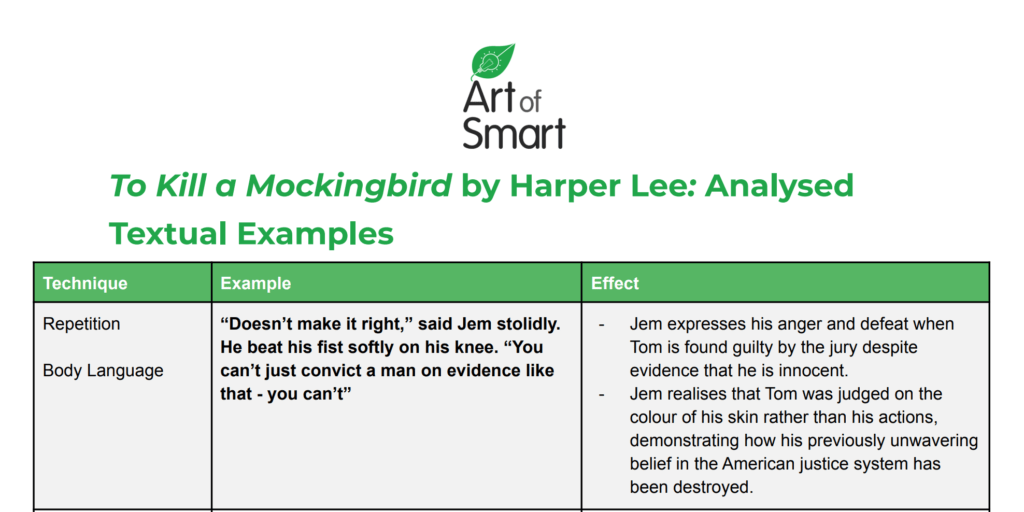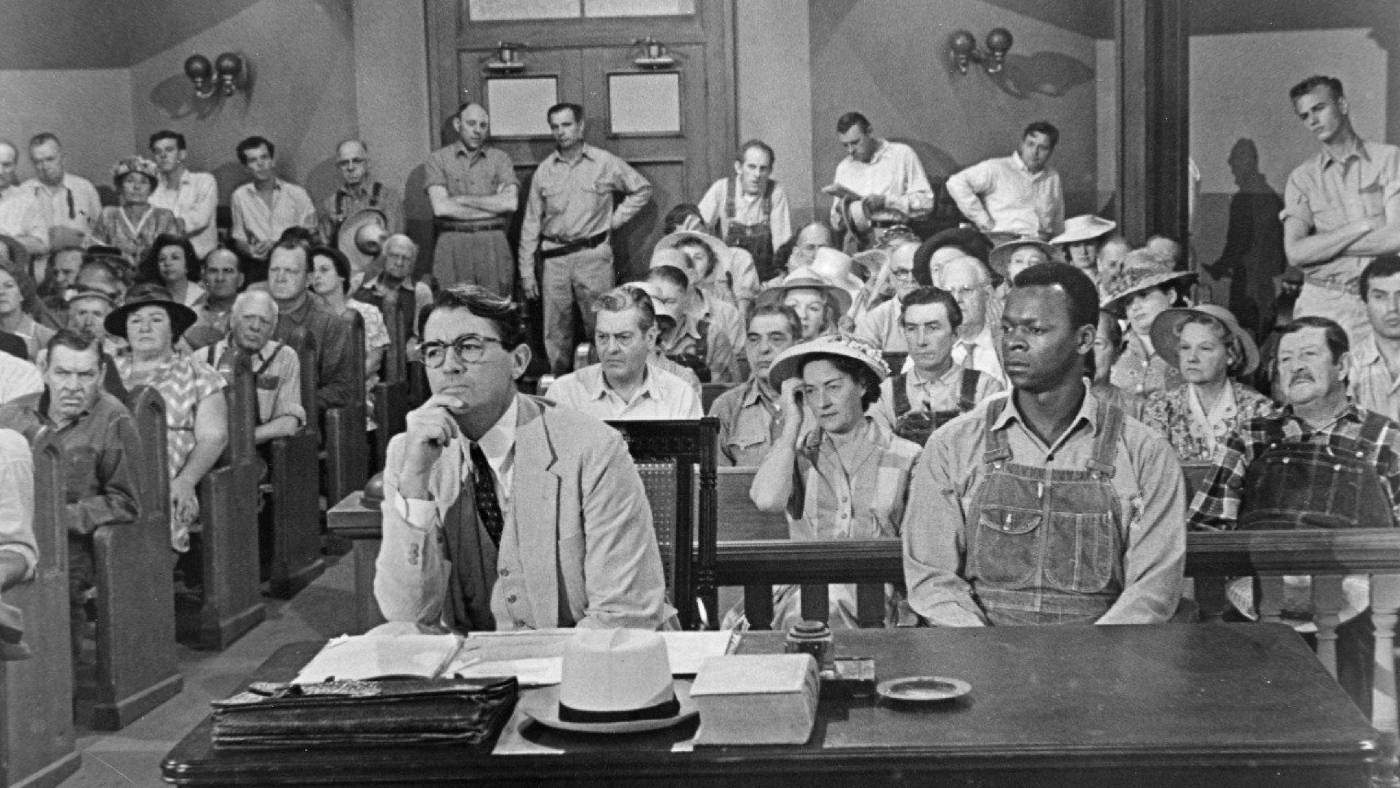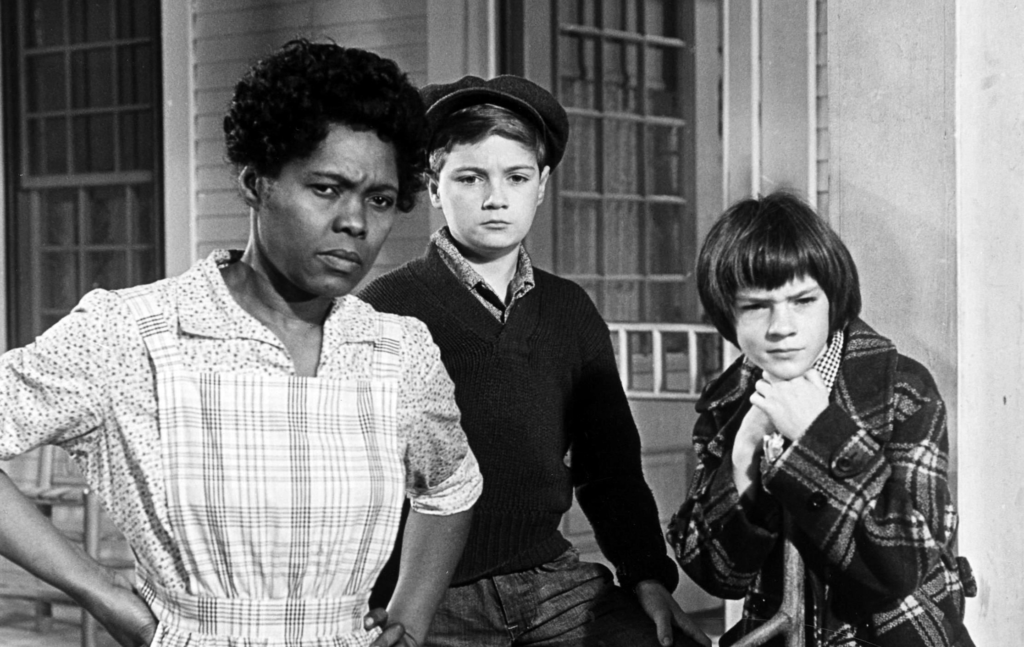One of the classics of American literature, ‘To Kill a Mockingbird’ has been assigned to you for your English class and you need to conduct an essay analysis. Whether you’re looking for a summary of the themes in To Kill a Mockingbird or a quick refresher of the key characters or context, we’ve got you!
You’ll also be able to download a copy of our analysed textual examples, as well as a sample paragraph so you can ace your tasks.
Let’s take a look together!
To Kill a Mockingbird Summary
Key Characters in To Kill a Mockingbird
Symbols in To Kill a Mockingbird
Context
Themes Explored in To Kill a Mockingbird
Essay Analysis of To Kill a Mockingbird
Summary of To Kill a Mockingbird
To Kill a Mockingbird is a novel that centres around the Finch family and is told through the perspective of Jean (nicknamed Scout), within the town of Maycomb, Alabama. Atticus, Jean’s father, is a prominent lawyer and the family lives relatively comfortably despite the impacts of the Great Depression.
Image sourced from Wikimedia Commons
Scout, her brother Jem and their friend Dill spend the summer together where Dill eventually becomes fascinated by the Radley’s house where Boo Radley, a mysterious and ghostly figure that is the topic of much speculation and stories for the children of Maycomb.
Scout and Jem find gifts in the knothole of a tree on the Radley property, but Nathan Radley chases the children off the property and eventually seals up the knothole. When a fire breaks out, Jem tells Atticus that Boo is caused it.
The climax of the novel arrives when Atticus agrees to defend Tom Robinson, a Black man who has been accused of raping a white woman. As a result, Scout and Jem get bullied by other children in their conservative, racist town.
At a pivotal moment, Mrs Dubose, the neighbour of the Finch family, harasses the children and Jem lashes out by destroying her garden.
As punishment, Atticus tells Jem to read to Mrs Dubose every day, explaining to the children that she is addicted to morphine and trying to overcome her addiction. Thus, despite the children’s initial indignation, Atticus teaches them an important lesson in empathy and perspective.
When Tom Robinson’s trial begins, he is held in the local courthouse where a group of people gather planning to lynch him. Atticus confronts the group the night before the trial, where Jem and Scout sneak out of the house to join him.
Recognising one of the men, Scout gently asks him how his son is doing, unknowingly shaming him and causing the group the disperse.
At the trial, the siblings choose to sit with the town’s Black citizens as Atticus presents clear evidence that Mayella and Bob Ewell are lying about the rape.
Atticus demonstrates that the injuries on Mayella’s face are wounds from Bob when he found her with Tom. However, despite the convincing evidence indicating Tom’s innocence, the all-white jury convicts him.
Tom is killed later on when he tries to escape prison. Additionally, despite his success at the trial, Bob Ewell feels that he has been made a fool and takes revenge.
First, he harasses Tom’s widow before finally attacking Jem and Scout as they walk home from a party. However, the children are saved by Boo Radley who fatally stabs Ewell during the struggle.
Boo carries an injured Jem home and Atticus insists that Ewell tripped over a tree root and fell on his knife to protect Boo. The novel ends with Scout walking Boo home and reflecting on the events of the novel and the complexities of humanity.
Key Characters in To Kill a Mockingbird
Jean Louise ‘Scout’ Finch
Jean Louise ‘Scout’ Finch is the main character and we first met her when she is 6 years old, although it is narrated by an older Scout who is reflecting and looking back on her life.
Through her, we learn about the town, her family and what it was like to live in the early 1930s during the Great Depression and the racial tensions that existed during that time.
Atticus Finch
Atticus Finch is a single father in To Kill a Mockingbird who is appointed as the defence lawyer for a Black man who is accused of raping a White woman. Throughout the novel, Atticus teaches the children about empathy and how to view situations from different people’s perspectives instead of judging them harshly.
Jem Finch
Jem Finch is Scout’s older brother who looks up to their father a lot. As an older brother, Jem accompanies Scout for a lot of her adventures and it is evident that the two are close.
Being older, we watch Jem mature and often understand issues that Scout still does not.
Tom Robinson
Tom Robinson is the Black man who Atticus defends during the rape trial. During the trial, there is compelling evidence that Tom is innocent and that the Ewells falsely accused him of rape. Despite this, Tom Robinson is found guilty due to the jury’s racial prejudice.
Boo Radley
Arthur ‘Boo’ Radley is the Finch’s mysterious neighbour which the children in the town often speculate and make up scary stories about him. While he was a teenager, Boo was part of a gang of boys who caused trouble in Maycomb by drinking and gambling.
As a result of this, he was locked in his home for many years and not allowed out. However, he has a soft spot for the children, leaving them gifts in the knothole of a tree and saving Jem when he is attacked by Bob Ewell.
Symbols in To Kill a Mockingbird
Mockingbird
In “To Kill a Mockingbird,” the symbolic significance of the mockingbird resonates deeply. It represents innocence and goodness. Atticus Finch’s advice to his children, Scout and Jem, to never harm a mockingbird metaphorically extends beyond the bird itself. The innocent characters like Tom Robinson and Boo Radley are likened to mockingbirds, as they bring no harm but are subjected to cruelty and injustice due to societal prejudices.
The Radley Place
The ominous Radley house and its reclusive occupants, particularly Boo Radley, symbolise the fear of the unknown. The town’s gossip and myths surrounding the Radleys serve as a reflection of the community’s prejudiced attitudes. Boo Radley, initially feared and misunderstood, eventually becomes a symbol of compassion and kindness, challenging the town’s preconceived notions.
These symbols intricately weave into the narrative, adding layers of depth to the novel’s themes of innocence, prejudice, empathy, and the complexities of morality and human behavior.
Context
To Kill a Mockingbird is set in Alabama during the 1930s, allowing Harper Lee to explore the impact of racism and the Great Depression on people. While slavery had been abolished in 1890, most White Americans continued to hold racial prejudices against them.
Segregation laws meant that Black people were separated from White people. This is reflected in Maycomb where they live in a separate part of town and even sit in a separate area during Tom Robinson’s trial.
Image sourced from Britannica
Additionally, Lee demonstrates the racism in America during this time through the town’s response to Atticus agreeing to defend Tom and his subsequent trial. From the children being harassed, the attempted lynching of Tom and finally being found guilty by the jury despite overwhelming proof of his innocence, the novel demonstrates how racism affected Black people in all aspects of their lives during this time.
While the novel was set in the 1930s, Lee wrote it during the 1960s when the Civil Rights Movement was happening. The legal system continued to be discriminatory towards Black people, thus many of the racial themes that Lee explores in the novel would easily be recognisable to the public when the book was published.
The continued relevance of To Kill a Mockingbird during the 21st century can still be seen in the Black Lives Matter movement in America and ongoing racial injustices.
Image sourced from Minnesota Historical Society
Themes Explored in To Kill a Mockingbird
As you read through To Kill a Mockingbird, you will encounter themes such as:
- Racism
- Class
- Empathy and courage
- Loss of innocence
The Complexities of Humanity
To Kill a Mockingbird explores the complexities of humanity and how both good and evil can exist at the same time within people. Told through the perspective of Scout between the ages of 6-9, readers are offered an opportunity to watch Scout mature while also learning alongside her.
Social Prejudice
Themes of social prejudice are also strong within the novel, featuring various social outcasts from Mrs Dubose who is a morphine addict, Boo Radley and the Black citizens of Maycomb.
Through these characters, Lee is able to explore the different prejudices society often holds and encourages us to be empathetic to people we may think of as unpleasant or weird due to their differences or behaviours. Instead, we are encouraged to see a different point of view and “climb into his skin and walk around in it”.
The Enduring Relevance of the Text
While To Kill a Mockingbird was set in the 1930s and written in the 1960s, many of the themes continue to remain relevant more than 50 years later. It is likely that your English classes will ask you to consider why we continue to study this book and what it teaches us about social prejudices.
While segregation may be a thing of the past, themes like racism’s impact on the justice system can still be seen in movements like Black Lives Matter. Additionally, while the book deals with racism specifically, social prejudices like how we interact with people from different backgrounds, those with a disability or LGBTQ+ people can also be examined through this book.
Events to Keep in Mind
While Tom Robinson’s case is the climax of the novel, there are various characters and events that you should keep a lookout for as well!
From the children going to the Black church, their interactions with Mrs Dubose and Boo Radley — there are various events where the children build empathy and challenge their own opinions of other citizens in the town, providing an opportunity for the readers to learn alongside them too.
How to Analyse To Kill a Mockingbird in 3 Steps
Usually, when students try to write their essay for To Kill a Mockingbird, or any other text, they’ll try to work on their thesis first when responding to an essay question — however, we recommend starting with your analysis!
Doing this will allow you to expand your knowledge of the text before thoroughly answering anything about it. Once you’ve analysed your text, then you can draw ideas from it and properly build your thesis.
We’re going to walk you through writing up an essay analysis for To Kill a Mockingbird in three simple steps!
Step 1: Choose your example
When picking an example ensure that you are able to identify a technique in the text.
Here, we have chosen to look at Atticus’s statement to the Court and jury at Tom Robinson’s trial:
“We know all men are not created equal in the sense some people would have us believe – some people are smarter than others, some people have more opportunity because they’re born with it, some men make more money than others, some ladies make better cakes than others… But there is one way in this country in which all men have been created equal… That institution, gentlemen, is a court.”
This is quite a long quote from To Kill a Mockingbird, so remember when you’re actually writing up your analysis for your essay, you don’t actually need to include the complete quote — just excerpts.
We’ve got a list of 50 quotes that you should check out from To Kill a Mockingbird!
Step 2: Identify your technique(s)
Ensure that the technique you choose for your quote supports your analysis or helps you to build your argument.
To enhance your response, you want to discuss techniques that have a lot more depth — you should keep an eye out for any literary techniques such as metaphors, similes and motifs!
For the above quote, there is repetition, cumulative listing, inclusive language and allusion.
Step 3: Write the analysis
When writing the analysis, focus on the effect of the technique and how it supports your argument. In this case, we are going to analyse how the quote addresses the theme of racial prejudices.
The opening of “we know all men are not created equal” subverts the American declaration of independence, as Atticus utilises cumulative listing to demonstrate all the ways in which men and women are not equal.
However, he also reminds the jury during this trial that the law is a “way in this country in which all men have been created equal”, alluding to the American Declaration of Independence and the core values of the nation. Analysis for this quote may look like:
Atticus, aware that the jury is likely to find Tom Robinson guilty despite strong evidence of his innocence due to the racial prejudices the White jury is likely to hold tries to challenge this through the inclusive language of in “we know all men are not created equal”, Atticus presents the jury and the defence as being on the same side. Furthermore, the allusion to the core American values when he states “in this country there is one way all men have been created equal”, creates an appeal to both the jury’s sense of justice and core American values.
Need to write a Feature Article on ‘To Kill a Mockingbird’? Look no further than this incredible in-depth guide to help you ace your writing!
Need some help analysing other texts?
Check out other texts we’ve created guides for below:
- All the Light We Cannot See
- Lord of the Flies
- Hamlet
- The Meursault Investigation
- Jane Eyre
- Mabo
- In Cold Blood
- Amélie
- Pride and Prejudice
- Jasper Jones
- Romeo and Juliet
Read also: how to write a feature article for English!
Are you looking for some extra help with your essay analysis of To Kill a Mockingbird?
We have an incredible team of QCE tutors and mentors!
We can help you master your essay analysis of To Kill a Mockingbird by taking you through the summary, key characters and themes. We’ll also help you ace your upcoming English assessments with personalised lessons conducted one-on-one in your home or online!
We’ve supported over 8,000 students over the last 11 years, and on average our students score mark improvements of over 20%!
To find out more and get started with an inspirational QCE tutor and mentor, get in touch today or give us a ring on 1300 267 888!
Tiffany Fong is currently completing a double degree in Media and Communications with Law at Macquarie University. She currently contributes to the university zine, Grapeshot where she enjoys writing feature articles, commentary on current affairs or whatever weird interest that has taken over her mind during that month. During her spare time, Tiffany enjoys reading, writing, taking care of her plants or cuddling with her two dogs.








